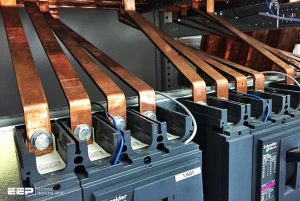Author: Usman Karneh
The function of an electrical system is to safely convey the power from the point of generation (source) to where it is required the various loads or equipment connected to it. The electrical source, like the load may either be a single phase (2-wire) or three phase (3 to 4- wire) system

An electrical system can take any of two forms:
Neutral Insulated system, or
Neutral Earthed system.
For single phase neutral insulated system, the neutral of the source is insulated. In other words, the neutral is not connected to the earth. While for the neutral earthed system, the neutral of the source is connected to the earth.
For three phase star neutral insulated system, the common point of the source is not connected to earth. Hence there are only 3 phase wires R,Y,B emerging from the source. In neutral earthed system, the star point is earthed to ground. So 4 wires emanate from source (3 phase and 1 neutral).
Three (3) types of fault may occur in an electrical system:
Open circuit fault: is the result of a break in the conductor so that no current flow through the load.
Short circuit fault: is due to break in insulation and two conductors (line and neutral) are directly touching each other resulting into a short path to current flow and allowing a very large current to bypass the load.
Earth Fault: This is also due to insulation breakdown which somehow allow the conductor to come into direct contact with the metal enclosure or body frame of the equipment.
A single earth fault occurring in the line of an earthed neutral system, would be equivalent to a short circuit fault since this will creates a closed path for the earth current to flow through to the ground as a result of minimal resistance, this earth current may increase to a very large extent. If the earth current increases beyond the current rating of the generator, the entire system may collapse causing irreparable damage. To limit this earth current, a Neutral Earthing Resistor is connected to the earthed neutral of the source. This resistor is of sufficient ohmic value to limit the earth current within rating of the generator. However, the magnitude of earth current is sufficiently large to operate the tripping mechanism of the faulted equipment immediately isolating it from supply and rendering it safe.
A single earth fault in a neutral insulated system, would not cause any earth current to flow. This is because a single earth fault current does not provide a complete circuit for earth current to flow. So no protective trip will operate and system will continue to function normally.
However, if a second earth fault occurs on another line in the insulated system, the two earth faults together will be equivalent to a short circuit and the resulting earth fault current will operate the available protection devices and cause disconnection of services.
For system where the priority requirement is to maintain continuity of the electrical supply to essential equipment in event of a single earth fault occurring the isolated neutral (neutral insulated) system is used. For system where the priority requirement is the immediate isolation of earth-faulted equipment is automatically achieved by a neutral earthed system.
To understand this better, a case study is used; If the earth fault occurs in an essential system like that of steering gear of a ship, then in case of: Insulated neutral system, no earth fault current will flow and the steering gear will continue to operate until there is a second earth fault in any equipment present onboard. Hence, with a single earth fault, the essential service will continue to operate.
If the system would have been an earthed neutral, then a single earth fault would have caused heavy earth current to flow and operate the tripping mechanism causing shutting down of steering gear. This will seriously compromise the safety of the ship navigation. Hence, it is well understood that onboard a ship, a neutral insulated system is to be used while, in an industry or on shore installations neutral earthed system is used.
Shipboard main LV systems at 440 V are normally provided with neutral insulated system. On the other hand HV system (1000 V to 3.3 KV) are usually provided with neutral earthed system via a neutral earthing resistor.
In a HV system, certain essential loads can be supplied by a transformer with it’s secondary insulated to ensure no earth fault current flows in the equipment in order to maintains the continuity of service.
Shipping regulations require that the hazardous areas of tanker such as the cargo area, pump room should have a neutral insulated system to prevent any stray earth current from flowing in the hull and causing explosion hazard.
However an exception is included in case if tanker has a 3.3 KV system, the earthed system is permitted provided that the earthed system does not extend forward of engine room bulkhead and into the hazardous area.
Both the Insulated neutral and Earthed neutral system have got their own advantages and disadvantages. Where it is easier in the earthed neutral system to detect any earth faults in system, it is easier in isolated neutral system to maintain the continuity of service.